This article describes the use of old Soviet and other manual optics on any Nikon digital-mirror and system cameras.
In this article, the terms "old optics", "manual optics", "old lenses", "Soviet lenses", "lenses without CPU" can be considered synonymous.
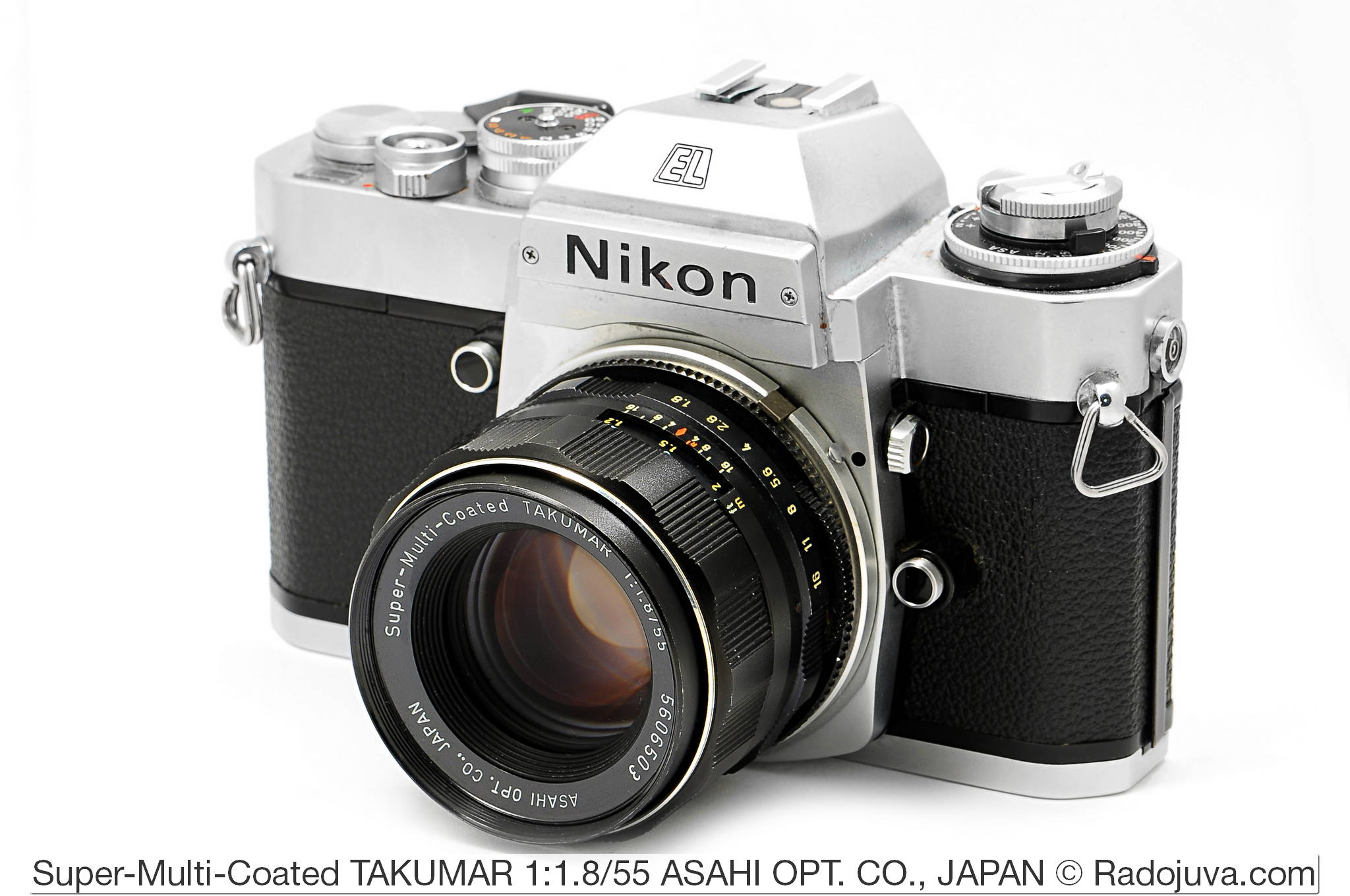
Lens Super-Multi-Coated TAKUMAR 1: 1.8 / 55 ASAHI OPT. CO., JAPAN with M42 mounting thread shown on a film SLR camera Nikon EL2. Installation done using M42-Nikon F adapter without lens and chip.
Navigation:
- 'H' mount lenses
- Lenses 'Automatic' from cameras Kiev-10, Kiev-15
- Lens with interchangeable shank 'A'
- Lenses with M42 mounting thread
- Lenses with M39 mounting thread
- Lenses with 'K' mount
- Lenses with bayonet mount 'B' (Pentacon SIX), 'B' (Salute)
- Lenses from 'U' enlargers
- Lenses with a Contax-Kiev RF mount
- Other Soviet lenses
- Older Nikon 1 CX lenses and system cameras
- How to use such lenses on modern Nikon central control centers
- How to focus?
- How to control the diaphragm?
- exposure
- List of cameras that support auto metering
- List of cameras that do not support auto metering
- How to work with flash?
- How to shoot a video?
- Why use such lenses at all?
- Lens Guidelines for Nikon CZK
- Conclusions :)
- Another article of mine on Soviet optics
By and large, if you arm yourself to the teeth with files and similar tools, you can attach any old lens to modern Nikon cameras. The only difficulty is how he will shoot after that. If there is no desire to modify and alter lenses, then there are a number of lenses that can be used with Nikon cameras without any problems without any alterations.
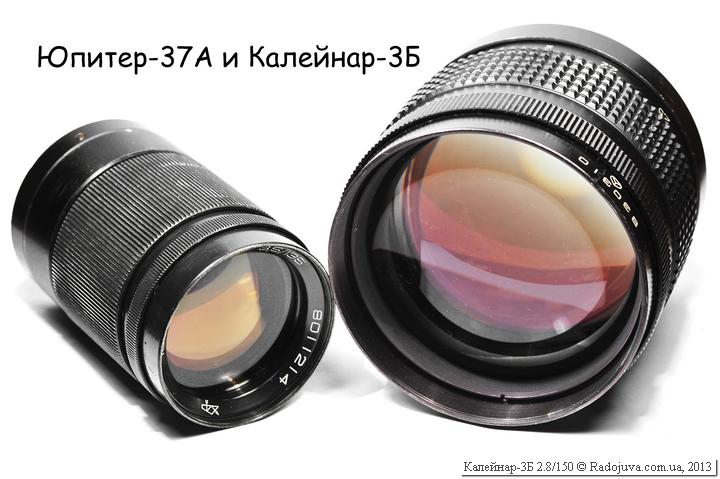
Jupiretr-37A and Kaleinar-3B
All Soviet lenses don't have auto focus and are manual focus lenses, these lenses are often called 'manual'from the English. Manual Focus Lens - manual focus lens, or simply, 'manual lens', 'manual', MF.
All old lenses can be divided into several types depending on the thread of the lens to the camera. Whether you can attach a Soviet lens to a Nikon system directly depends on the thread (rear of the lens). Also, the lens mount is called bayonet mount.
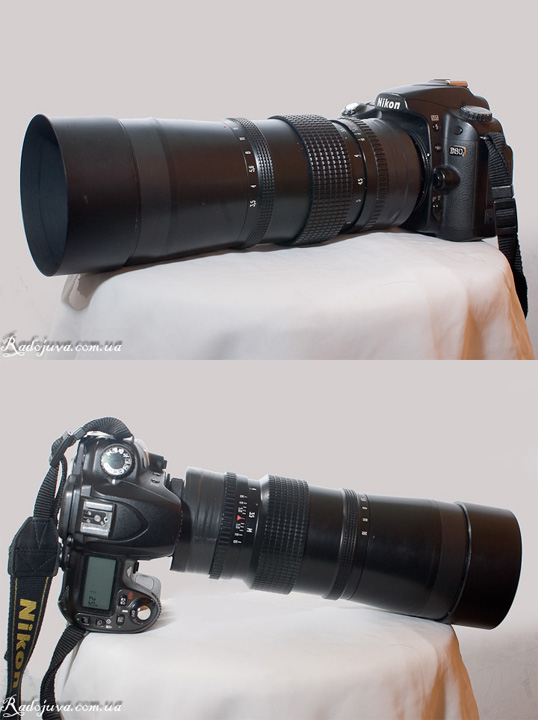
Soviet lens Jupiter-36V on a modern Nikon camera with two adapters
Nikon uses Nikon F mount, which has been with the company since 1961 and is almost the same on all Nikon cameras. This is pretty good news, as you can still take any of the oldest lenses. AI-S from Nikon for a film camera and use it on modern digital SLR cameras.
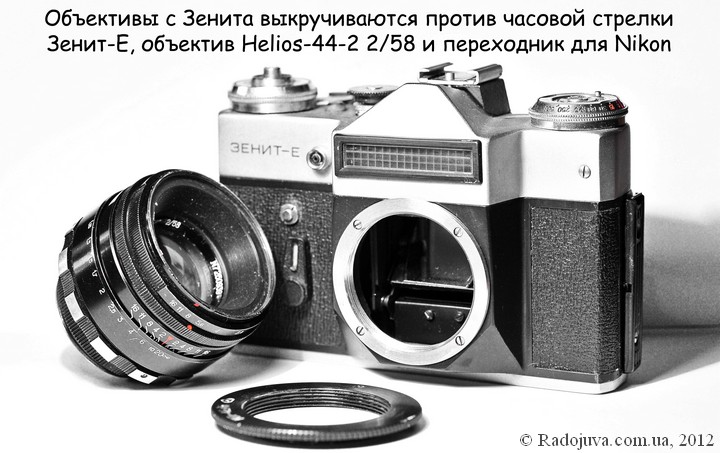
How to remove the lens from the Zenith
'H' mount lenses
Now there are a lot of Soviet lenses that use the Nikon mount. Exists bayonet H, which was copied from the Nikon F mount and is fully compatible with it. The cameras that used it: Kiev-17 and Kiev-17m, Kiev-18, Kiev-19 and Kiev-19m, Kiev-20. That is, when using lenses from these cameras there will be no problems with installing the lens on Nikon. Most often, such lenses had the designation "H" at the end of the name.
List of lenses with H mount (Nikon F) for which you do NOT need an adapter:
- MS Helios-81N 50mm F2.0 (triple name Arsat-H 50mm F2.0)
- Helios-81M 53mm F2.0
- MS Helios-123N 50mm F1.4 (second name Arsat-H 50mm F1.4)
- MS Zenitar-N 16mm F2.8 Fisheye
- MS Mir-73N 20mm F2.8 (second name ARSAT H 2,8 / 20)
- Mir-20N 20mm F3.5
- MS Mir-24N 35mm F2.o
- MS Kaleinar-5N 100mm F2.8 (second name ARSAT H 2,8 / 100)
- Tele-H 200mm F3.5
- MS Granite-11N 80-200mm F4.5 (second name Arsat 80-200 1: 4.5)
- MS Bearing-H 8mm F3.5 (Belomo EWP Fisheye Lens MC 8mm F3.5 H)
- MS Mir-47N 20mm F2.5
- MS Jasper-4N (I dream to find it and test it)
- MS Wave-8 50mm F1.2
- MS Zenitar N 50mm F1.7 (F2.0) (the availability of the H version is not known exactly)
- MS Amber 14H F2.8-4 28-85mm
Lenses with an “H” designation are almost always AI-S lenses for Nikon, that is, they are completely identical to the old manual lenses from Nikon itself.
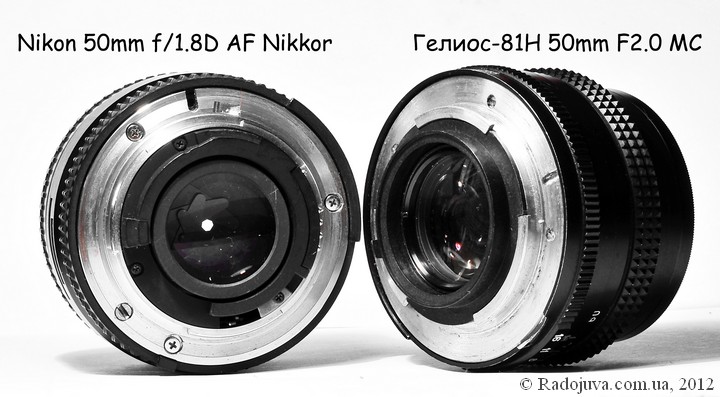
Almost the same mount on Nikon and Helios-81n
Cameras with mount Kiev-Avtomat
Very important: at the cameras Kiev-10 and Kiev-15 unusual unique bayonet mount. The lenses for these cameras were most often labeled as “Automatic“. For example, Helios-81-Avtomat. They cannot be used with Nikon cameras. There are no adapters for these lenses. If there is a desire to install such a lens, then you will need to alter it yourself, while you will face the problem of different flange focal lengths for Nikon and Kiev-10, -15. Very often people confuse cameras Kiev-10, 15 with their brothers like Kiev-19.
Here is the most complete list of such lenses:
- MIR-20 3.5 / 20 AUTOMATIC
- MIR-1 2.8 / 37 AUTOMATIC
- HELIOS 65 AUTOMATIC 2/50
- HELIOS-81 2/53 AUTOMATIC MACHINE He also HELIOS-81 2/50 AUTOMATIC MACHINE he is HELIOS 81 2/53 AUTOMATIC (name without a dash between 'Helios' and' 81 ′.)
- JUPITER-9 2/85 AUTOMATIC
- JUPITER-11 4/135 AUTOMATIC
- ERA-6 1.5 / 50 AUTOMATIC (suddenly !, prototype)
- RUBIN-2A 3.5 / 45-80 AUTOMATIC (prototype)
- GRANITE-11 4.5 / 80-200 AUTOMATIC (see)
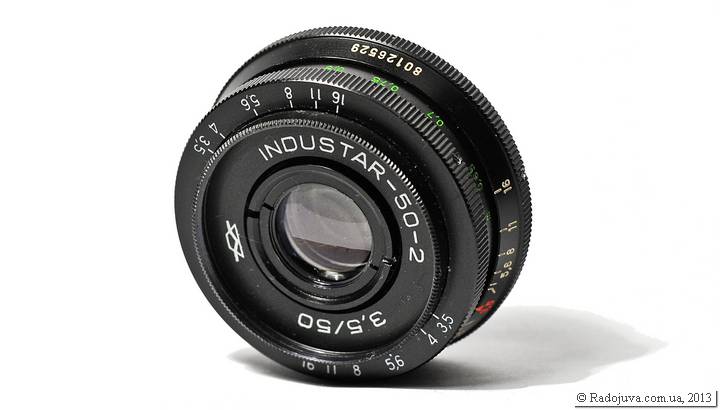
Little Industar
Lens with interchangeable shank 'A'
Exist lenses with letter “A” at the end of the designation. They have the ability to use the interchangeable shank shown in the photo below.
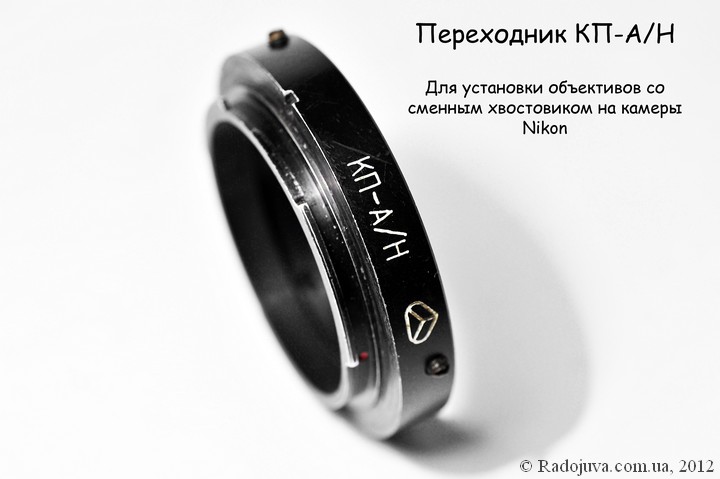
Adapter KP-A-N
The interchangeable shank is the back of the lens that can change depending on which camera the lens was to be mounted on. For these lenses and Nikon cameras, you can use the shank KP-A / N.
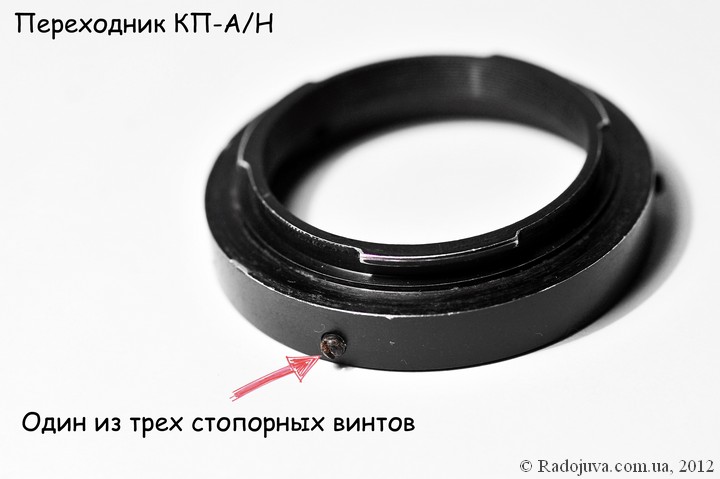
Adapter KP-AN, locking screw
With such an adapter it will be possible to obtain focusing at infinity and MDF while maintaining the focusing distance scale. Also, there are rumors that the “A” versions of lenses are technically better performed than their “A” counterparts.
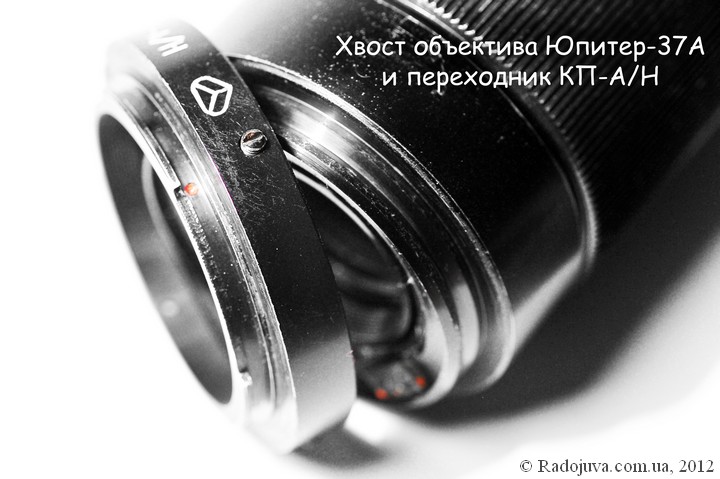
Adapter KP-A-N and lens with interchangeable shank
A list of some lenses with interchangeable shank “A”:
- Jupiter-37AM 135mm F3.5 MS
- Jupiter-37A 135mm F3.5
- Jupiter-11A 135mm F4 (there are other options, for example, Jupiter-11 under M39)
- Tair-11A 135mm F2.8
- World-10A 28mm F3.5
- Mir-1A 37mm F2.8 (available in other versions, for example Mir-1V under M42)
- Industar-61A 50mm F2.8 (is in other options, for example under Industar-61 L / Z MS under M42)
- Jupiter-21A 200mm F4.0 (is in other options, for example under M42)
- Tair-3A 300mm F4.5 (available in other versions, for example Tair-3 FS under M42)
- MS Bearing A 17mm F2.8
- MS Bearing A 8mm F3,5
- Jupiter-9A (there are other options, for example, Jupiter-9 under M39)
- Vega-13A 100mm F2.8
- Era-6A 50mm F1.5
- Tair-56A 150mm F2.8
- Telemar-22A 200mm F5.6 (is in other options, for example Telemar-22)
- 3M-4A 500mm F6.3
- 3M-5A 500mm F8 (may not have a replaceable shank)
- 3M-5CA 500mm F8 (may not have an interchangeable shank)
- 3M-6A 500mm F6.3 (may not have a replaceable shank)
- MTO-500A 550mm F8.5
- MTO-11 1000mm F10 (found and MTO-11A)
- MTO-11SA 1000mm F10
- MTO-1000A 1100mm F10.5
Very important: the KP-A / H adapter is a copy of the T2 mount adapter. These adapters are functionally the same.
Where to buy the T2 mount adapter (KP-A / N)
The cheapest adapters can be ordered at aliexpress.com... Buy adapter T2 - Nikon F here.
Lenses with M42 thread
Go further M42 lenses, the use of which imposes some difficulties when working with the Nikon system. The working segment M42 is shorter than Nikon’s, because here the problem of focusing on infinity... There is an adapter for installing such lenses on Nikon cameras KP-42 / N и KP-42 / N with a lens. These adapters are also called M42-Nikon и M42-Nikon with correction lens.
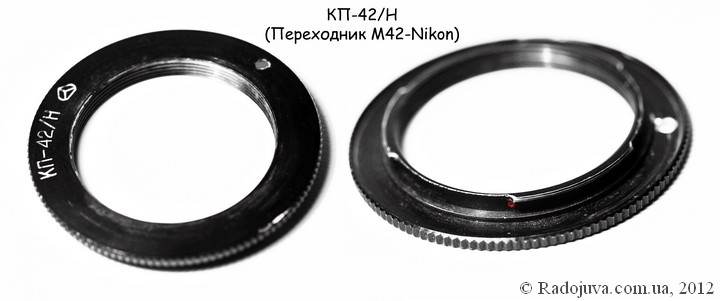
Adapter M42-Nikon
When using a conventional adapter KP-42 \ N the ability to focus at infinity will be lost. An adapter with a lens will make it possible to focus on infinity, but alas, the lens will make adjustments to the optical design and image quality. More details about image quality using an adapter with a lens can be found here.
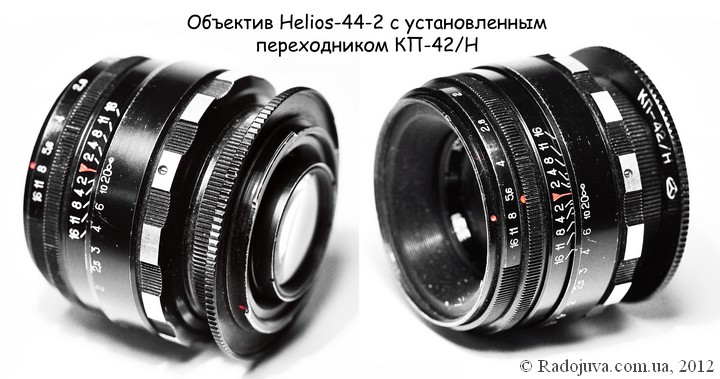
Lens with Nikon adapter installed
Attention : The loss of the ability to focus at infinity means that when using a lens for M42 cameras with a lensless adapter, it will be able to focus up to several meters. The maximum focusing distance depends on the lens, so for Helios with a focal length of 50mm, it will be possible to focus somewhere up to two meters. For 300mm Tair-3 it will be possible to focus up to 30 meters. The longer the focal length, the longer the maximum focusing distance with lensless KP-42 \ N.
Attention: adapter M42-nikon without a lens still works as thin macro ring, because the minimum focusing distance with such an adapter at the lens is reduced, which contributes to better close-ups.
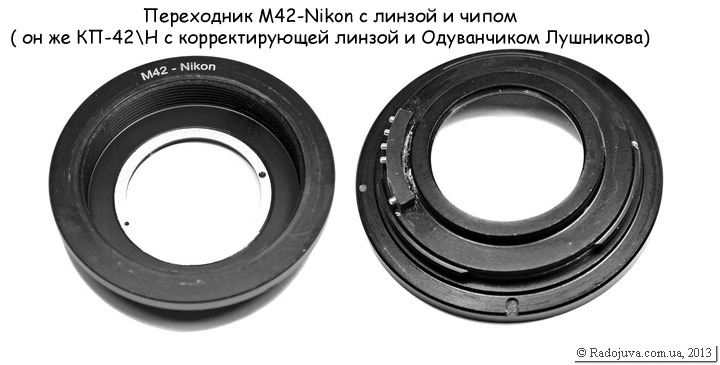
Lens adapter
Examples of lenses with M42 thread:
- Era-6M 1,5 / 50
- Helios-40-2 85mm F1.5
- Helios-44 58mm F2.0 (white, m39, Krasnogorsk, 13 petals)
- Helios-44 58mm F2.0 (white, m39, Krasnogorsk, 8 petals)
- Helios-44M 58mm F2.0 (two lenses: Valdai and KMZ)
- Helios-44-2 58mm F2.0 (two lenses: Valdai and MMZ)
- Helios 44-3 58mm F2.0 MS
- Helios-44M-4 58mm F2.0
- Helios-44M-5 58mm F2.0MC
- Helios-44M-6 58mm F2.0 MS
- Helios-44M-7 58mm F2.0MC
- Helios-77M-4 50mm F1.8 MC
- Helios-77M 50mm F1.8MS
- Jupiter-9 85mm f2.0
- Jupiter-38 75mm F4.0
- Mir-1V 37mm F2.8
- Tair 3 FS 300mm F4.5
- Granite-11M 80-200mm F4.5 MC
- Industar-61 LZ MS 50mm F2.8
- Zenitar-M 50mm F1.7
- Telemar-22 200mm F5.6
- Wave-9 50mm F2.8 MC MACRO
All of the above applies not only to Soviet lenses with the M42 mounting thread, but also to any other old lenses, for example:
- Carl Zeiss Jena Flektogon 2,8 / 35
- Carl Zeiss Jena DDR Tessar 2.8 / 50
- Carl Zeiss Jena DDR Tessar 2.8 / 50 (the black)
- Carl Zeiss Jena Tessar 1: 2.8 f = 50mm T (white)
- Carl Zeiss Jena MC Pancolar 1.8 / 50 DDR
- Pancolar 1.8 / 50 ausJena
- Carl Zeiss Jena Flexon 2/50
- Carl Zeiss Jena Biotar 1: 2 f = 5,8cm T
- Carl Zeiss Jena DDR MC Sonnar 3,5 / 135
- PENTACON auto 1.8 / 50 MULTI COATING
- PENTACON auto 2.8 / 135 MC
- PENTACON auto 2.8 / 29 MULTI COATING
- PENTACON 3.5 / 30
- Auto Revuenon 35mm 1: 2.8
- Auto Revuenon 1.8 / 50 Multi Coating
- Auto Revuenon 1: 2.8 f = 135mm
Where to buy the adapter M42-Nikon F?
The cheapest adapters can be ordered at aliexpress.com. Buy adapter M42 \ Nikon F without a lens and a chip you can here, with a lens without a chip herewith chip without lens here, with lens and chip here.
M39
There are M39 lenses from SLR cameras. To install them you need to use two adapters KP-42 / N + M39 / M42or one adapter M39-Nikon. Of course, there will be no infinity with such an installation.
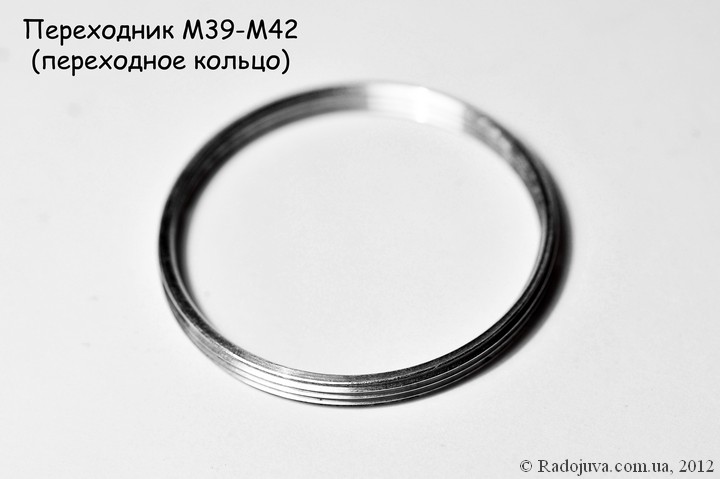
Adapter M39-M42
Attention 2: There is lenses from rangefinder cameras with M39 thread. No need to confuse rangefinder options from SLR. Installation of rangefinder lenses on the Nikon system is possible, but the ability to focus at infinity will be lost already in a few tens of centimeters. Such lenses are quite difficult to use on the Nikon system, and if used, then only for macro photography. More details in the section the use of rangefinder optics on SLR cameras.
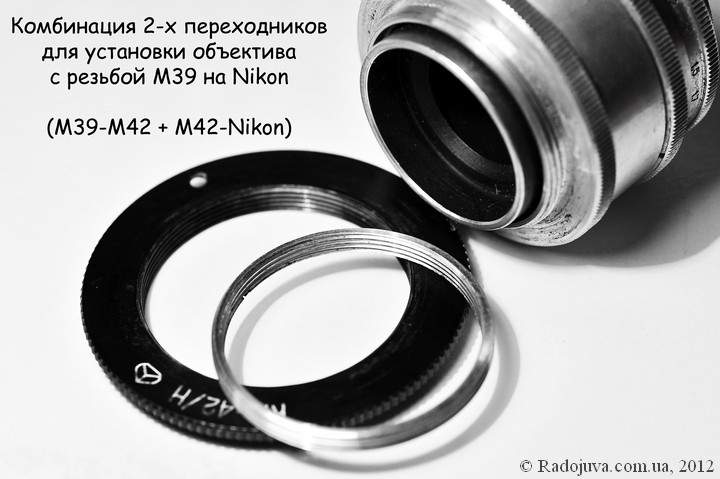
Using two adapters
Examples of M39 mount lenses
- Jupiter-9 85mm f2.0 (mirror version)
- Jupiter-11 135mm F4.0 (mirror version)
- Mir-1 37mm F2.8 (mirror version)
- Telemar-22 200mm F5.6 (mirror version)
- Industar-26m 50mm F2.8 P (rangefinder option)
- Jupiter-8 50mm F2.0 (m39, white, rangefinder)
- Jupiter-8 50mm F2.0 P (m39, white, rangefinder)
- Industar-26m 50mm F2.8 P rangefinder
- I-26m 52mm F2.8 rangefinder
- Industar-22 50mm F3,5 P rangefinder
Where to buy the adapter M39-Nikon F?
The cheapest adapters can be ordered at aliexpress.com. Buy adapter M39-Nikon F without a lens and a chip you can here. Also, replace one adapter M39-Nikon F You can use two adapters: M42-Nikon F + M39-M42.
Lenses with 'K' mount
Some cameras, such as Almaz-101, Almaz-102, Almaz-103 and Almaz-104, Zenit-KM, Zenit-Avtomat, Zenit-14, Zenit-AM, Zenit-AM-2, Zenit-AM-3, Zenit -APK, Zenit-APM, Zenit-122k, Zenit-212k, etc. had a K mount, which is completely identical to the mount Pentax K. These lenses can be used on modern Pentax cameras such as Pentax K30. In order to use the lenses in the K-mount on Nikon cameras, you need an adapter Pentax-Nikon. Adapters come with and without a lens. When using an adapter Pentax-Nikon without lens it will lose the ability to focus at infinity in the same way as for lenses with M42 thread when using an adapter without a lens. The working segment of the lenses with the K mount and the M42 thread is the same, is 45.5mm
Mostly Soviet 'K' mount lenses taken from brand cameras'Diamond'they have a good reputation as the camera brand was highly regarded at the time.
List of some Soviet lenses with K mount:
- MS Mir-47K 20mm F2,5
- MS Wave-10 35mm F1,8
- MS Wave 50mm F1,8
- MS Wave-4 50mm F1,4
- MS Vega-13 100mm F2,8
- MS Amber-12 35-100mm F3,5
- MS Mir-64 20mm F2.8
- MS Mir-20 20mm F3.5
- MS Mir-46 35mm F1.4
- MS Zenitar-K 16mm F2.8
- MS Zenitar-K 20mm F2.8
- MS Zenitar-K 28mm F2.8
- MS Zenitar-K 50mm F1.4
- MS Zenitar-K 50mm F1.9
- MS Zenitar-K 50mm F2.0
- MS Zenitar-K2s 50mm F2.0
- MS Zenitar-K 85mm F1.4
- MC APO Telezenitar-K 135mm F2.8
- MC APO Telezenitar-K 300mm F4.5
- MC Variozenitar-K 25-45mm F2.8-3.5
- MC Variozenitar-K 35-105mm F3.5-4.5
- MC Variozenitar-K 70-210mm F4
- MS Helios-77-4 50mm F1.8
Lenses with bayonet mount 'B' (Pentacon SIX), 'B' (Salute)
On Nikon you can use lenses from medium format cameras KIEV-C, Kiev-60, PENTACON-six. These cameras bayonet "B" (Pentacon six). For this you need an adapter Pentacon 6 / Nikon, which is called KP-6. At the same time, focusing on infinity is maintained. Such lenses, for example, include Carl Zeiss Jena Sonnar 180 2.8 Pentacon Six
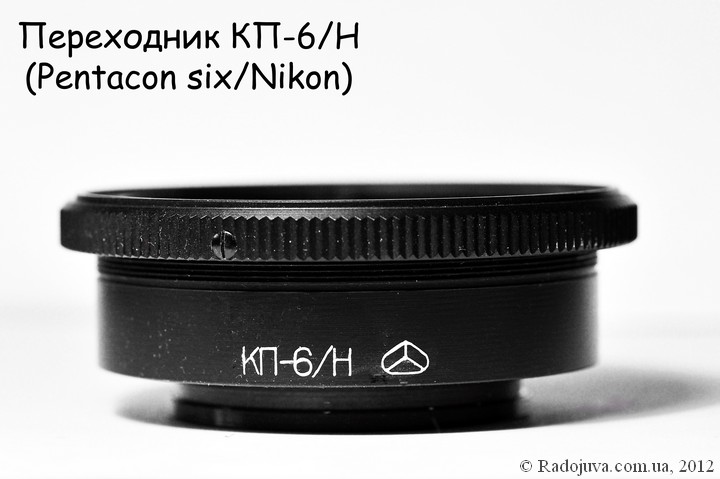
Adapter Pentacon 6 - Nikon
Also, you can use lenses from medium format cameras Kiev 88 / Salute... These cameras have a “B” mount. These lenses require two adapters: Kiev 88 / Salute on Pentakon six + Pentacon six / Nikon either one KP-88 / N.
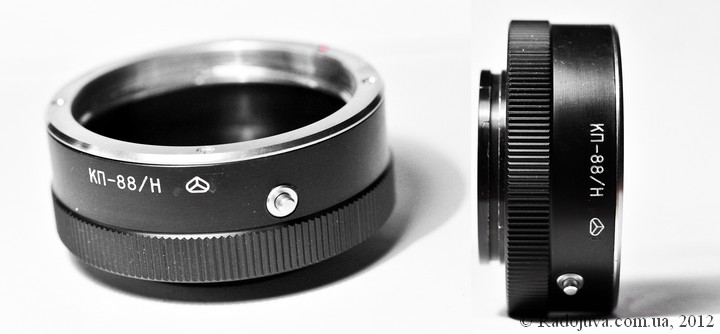
Adapter Salute 88 - Nikon
Attention 3: Bayonet “B” and “C” are different, they are not the same. People often get it wrong when they define the mount.
Attention 4: Adapters can often be combined. For example, there may be an adapter Kiev 88 / Salute on M42 + KP-42 / N and other combinations, depending on the needs. Most often I meet KP-A / 42 + KP-42 / N, which is not right, it is replaced by one KP-A / N.
List of medium format Soviet lenses
- Jupiter-36V 250mm F3.5 (ARSAT B 3.5 / 250)
- Mir-3V 65mm F3.5
- MIR-26V 45mm F3.5 (Arsat B 45mm 1: 3,5)
- Mir-38B 65mm F3.5
- Industar-29 80mm F2.8
- Vega-12B 90mm F2.8
- Zodiac-8B 30mm F3.5
- MS Mir-69B 45mm F3.5
- MS Wave-3 80mm F2.8
- Vega-2 86mm F2.8
- Industar-24 105mm F3.5
- Industar-56 110mm F2.8
- MS Vega-28V 120mm F2.8
- ZM-3V 600mm F8
- Kaleinar-3B 150mm F2.8
- Tair-33 300mm F4.5
- Tele-5V 250mm F5.6
When using medium-format lenses on Nikon cameras, it remains possible to focus at infinity with lensless adapters. Medium format lenses have virtually no vignetting effect even on full-frame cameras.
Where to buy the PENTACON SIX - Nikon F adapter?
The cheapest adapters can be ordered at aliexpress.com. You can buy an adapter with a chip here, adapter without a chip - here.
Lenses from 'U' enlargers
In those early days, when film was the rule, there were photo enhancers to work with negatives and positives. The enlargers had a special lens that did not have a focusing ring. These lenses often have good optical performance, especially good resolution. Taking pictures with such lenses is quite difficult, since it is very difficult to get into sharpness without a focusing ring. Most often they are used as macro lenses, where the classic focusing capability is not particularly needed. Usually, the name of the lens contains the letter 'У'. These lenses include:
Such lenses need conventional adapters for M39 or M42, which are described above.
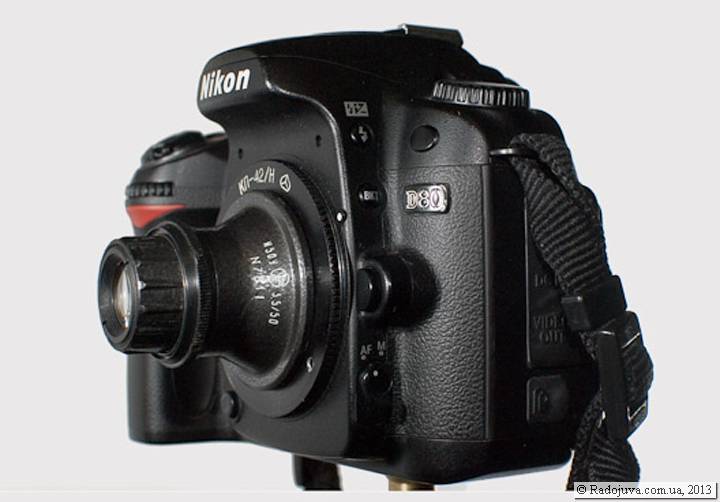
Zoom lens
Lenses with Contax-Kiev RF mount
Soviet rangefinder cameras Kiev-2, -2A, -3, -3A, -4M and -4AM, Kiev-5 (only external mount Contax-Kiev RF) and VTSVS / TSVVS (only internal mount) are equipped with the Contax-Kiev RF bayonet. Considering that these are rangefinder lenses, their use on SLR cameras is impossible. There are no adapters for Nikon cameras with Contax-Kiev RF mount. And the bayonet itself is quite specific, it consists of an inner and an outer part.
Lenses with internal mount Contax-Kiev RF:
- ZORKY ZK 1: 2 F = 5cm P, later renamed to 'JUPITER-8 ′
- JUPITER-8 1: 2 F = 5cm P (plant 'Arsenal' and KMZ)
- JUPITER-8M 2/50, aka JUPITER-8M 2/53 и JUPITER-8M 1: 2 F = 5cm P (there are actually other subversions)
- JUPITER-3 1: 1,5 F = 5cm P, aka JUPITER-3 1,5 / 50 and aka JUPITER-3 1,5 / 50 (ZOMZ)
- ZORKY ZK 1: 1,5 F = 5cm P, later renamed to 'JUPITER-3 ′
- HELIOS-103 1.8 / 53 (Arsenal plant)aka Helios-103 1.5 / 50 and aka Menopta 1.8 / 53
- ORCHID-3 F = 5,2cm 1: 1,5 (GOI, prototype)
- RUSSAR MR-2 5,6 / 20 (prototype)
Lenses with external mount Contax-Kiev RF:
- JUPITER-8 NB 2/50 (only suitable for Kiev-5)
- HELIOS-94 1,8 / 53 (only suitable for Kiev-5)
- ORION-15 6/28
- JUPITER-12 1: 2.8 F = 3.5cm P, aka JUPITER-12 2,8 / 35he is BK 1: 2.8 F = 3.5cm and he is the Sharp BK 1: 2.8 F = 3.5cm
- JUPITER-9 1: 2 F = 8.5cm P (Plant 'Arsenal'), aka JUPITER-9 2/85 (LZOS)
- JUPITER-11 1: 4 F = 13,5cm P (KOMZ), he JUPITER-11 4/135 (the latter has two identical options: KOMZ and KMZ)
- GOI SATELLITE-4 F = 2cm 1: 4.5 P (GOI, prototype)
- RECORD-4 0,9 / 52 (prototype, suitable only for Kiev-5)
- URANIUM F = 3,5cm 1: 2.5 (prototype)
- RECORD 1,8 / 50 (prototype)
- HELIOS-40 F = 8,5cm 1: 1.5 (prototypesuddenly!)
- RECORD-9 2.0 / 85 (prototype, later renamed JUPITER-9)
Other Soviet lenses
You can find a lot more custom lenses with different types of mounts. Basically, now you can easily find movie lenses, projection lenses, lenses from filmoscopes, lenses from projectors, microscopes, etc. In most cases, such lenses are very difficult to use and require serious alteration for installation on modern cameras.
Here are some of these lenses:
- 2/92 lens from the overhead projector Lati-60 / 60M
- F = 92 1: 2 lens from a slide projector Lety-60 / 60M
- MP RSFSR GLAVUCHTEHPROM Plant No. 6 77 mm lens from a filmoscope
- KO-120 120 mm F2.1 movie lens
Old Nikon 1 CX lenses and cameras
To Nikon 1 mirrorless system cameras with crop factor 2.7X include Nikon 1 S1, Nikon 1 S2, Nikon 1 V1, Nikon 1 V2, Nikon 1 V3, Nikon 1 J1, Nikon 1 J2, Nikon 1 J3, Nikon 1 J4, Nikon 1 J5, Nikon 1 AW1. note that Nikon 1 AW1 it cannot work with manual optics at all, it definitely needs a chip on a manual lens, but so far I have not seen such chips.
These cameras have a short flange focal distance, and any Soviet lens can be mounted on them. Usually the adapter is called 'bayonet / lens thread - Nikon 1'. With these cameras, you can focus to infinity using rangefinder lenses with an M39 mounting thread. True, these cameras do not know how to meter exposure with unchipped lenses. With their help it is difficult to focus, since they do not support the magnification of the image area with manual unchipped optics and in the video mode you also need to control the exposure pair yourself. But the built-in flash works without any problems. This is such a paradoxical system.
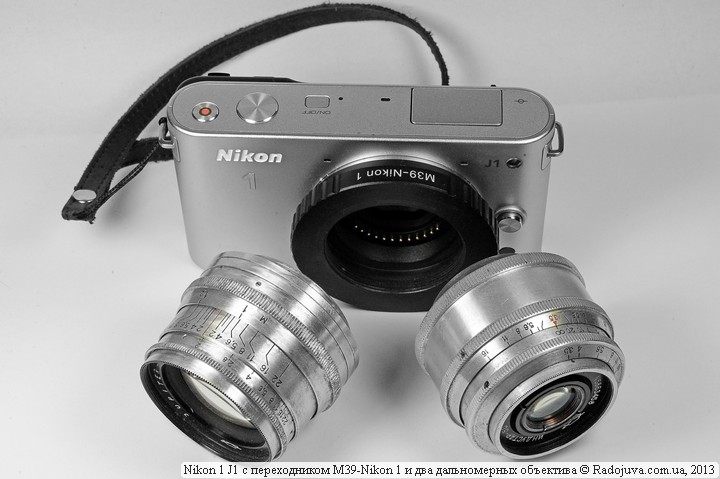
Adapter M39 - Nikon 1 Dual Lens
How to use old lenses without CPU contacts on modern Nikon digital SLR cameras?
Focus on non-CPU lenses
Forget about autofocus - when using old lenses, only MF (Manual focusing) is available. What will help get into the field of sharpness is green dot in the lower left corner any Nikon digital SLR camera. Point looks like this. The point works with any lens (actually without it). I advise you to choose from available focus points the desired one, make a tip from infinity to the desired value until it lights up and the green dot is constantly on. If it’s so difficult to catch a point, then you can focus from the minimum focus value to the desired one, catching the moment the green dot lights up. If it is very important to get at least one sharp shot, I advise you to use focus bracketing.
Attention: when working with manual optics all CZK from Nikon use focus only one point.
Attention: when working with lenses aperture which are less than F / 5.6, the green focus point practically does not work. For example, when using lenses with a small aperture, MS MTO-11 1000mm F10.0 or MS 3M-5CA 500mm F8 focus confirmation with a green dot does not work. Some Nikon cameras can provide focus confirmation with apertures up to F / 8.0. It can only Nikon D4, D4s, Df, D800,D800E, D810, D810a, D850, D600, D610, D7100, D7200, D7500 - in more detail in the section about focus systems Nikon.
Attention: the green dot is not a panacea. With many lenses, the green dot behaves differently and it is not always possible to use it to make the correct focusing.
Some cameras have a mode live view (live view, live screen) - it's like in a regular soap box - aiming through a normal camera display. It is very convenient to zoom in (do 1 to 1) a certain area of the image and set sharpness from the approximate image. The zoom is done when Live View is on and the button with the 'magnifier plus' icon is pressed. Live View have the following cameras: Nikon D3100, D3200, D3300, D3400, D3500, D5000, D5100, D5200, D5300, D5500, D5600, D300, D300s, D500, D90, D7000, D7100, D7200, D7500, D600, D610, D700, D750, D780, D800,D800E, D810, D810a, D850, D3, D3s, D3x, D4, D4s, D5, D6, Df+ Z series. It is very convenient to use this mode with a tripod.
Attention: scaling of the Live View image area on Nikon 1 S1, Nikon 1 S2, Nikon 1 V1, Nikon 1 V2, Nikon 1 V3 cameras, Nikon 1 J1, Nikon 1 J2, Nikon 1 J3, Nikon 1 J4, Nikon 1 J5, Nikon 1 AW1 not available. The Nikon 1 series was specially cut.
Interesting: some Nikon cameras have electronic range finderwhich works with manual optics. The essence of the rangefinder is that near the green dot, two arrows light up, which suggest in which direction you need to turn the focus ring to achieve a sharp picture. Manual rangefinders with manual optics do not work on all cameras, only on some, such as Nikon D700, D2x etc. You can read more about focusing on Nikon cameras. here.
Also, some lenses will not allow focus on infinity with certain adapters, this will limit the focusing area, often a number of lenses can be used only for portraits or for photographing subjects at close distances. In any case, the speed of work will greatly depend on the work experience. If autofocus is very important, then using dandelion lushnikov can be achieved pseudo auto focus (Effect focus traps), while in focus mode AF-A, AF-S camera will take a picture only when there is accurate focusing. With a dandelion Lushnikov will work electronic rangefinder for younger cameras, such as D3100, D5100 etc .. More details in the section Lushnikov dandelion.
Interesting: To simplify focusing through the viewfinder, you can set a special focusing screen. This screen is a replacement for the one in the camera. The screen has special zones and properties with which focusing is much easier. In more detail here. There are also interesting magnifying attachments for the viewfinder and external focusing screens for cameras with support for Live View.
Iris control
When using old lenses on modern Nikon cameras, the aperture control remains completely manual or semi-automatic. There are several types of lenses with different types of iris control:
- Lenses that have only manual iris control, for example, Helios-44. Typically, such lenses have a diaphragm preset ring. Presetting helps a lot to speed up the shooting process. Such lenses are very easy to use on modern central controllers
- Lenses with automatic aperture control only, for example, Helios-44m-6. In this case, it will be necessary to deceive the lens and block a special lever that “pushes”, and thereby closes the aperture. It is not difficult to do it with improvised means, so the diaphragm can be controlled manually.
- Lenses with an aperture control mode switch M / A, for example, Helios-44m. In this case, just set the switch to M mode and manually control the iris
- Lenses without aperture control. Such lenses include very rare lenses, for example, Helios 92mm F2.0
- Auto Iris 'H' series lenses such as Granite-11N 80-200 mm F4.5MC, with such lenses you need to set the value using the aperture control ring on the lens itself, and closing the aperture during shooting will be done by the camera itself.
- Native old Nikon lenses Pre-ai, AI, AI-S, AI-Converted. With such lenses, you need to set the value using the aperture control ring on the lens itself, and closing the aperture during shooting will be done by the camera itself.
In any case, the aperture value will need to be set using a special aperture ring on the lens. The easiest way to use AI on Nikon cameras is AI-S compatible auto iris lenses, like Helios-81H 2/50 or Kaleinar-5N 2,8/100.
Attention: when installed on a lower row of Nikon cameras in “M” mode, the camera display will display “F–” in the aperture value field. This is the normal state of the camera.
Metering
When working with the Nikon system, you will encounter exposure will not work on younger cameras.
Exact list of cameras that do not support auto metering with non-CPU lenses
Nikon D40, D40x, D50, D60, D70, D70s, D80, D90, D3000, D3100, D3200, D3300, D3400, D3500, D5000, D5100, D5200, D5300, D5500, D5600 и Nikon D100, D7500 (all of a sudden!) + Fujifilm FinePix S1 Pro, Fujifilm FinePix S2 Pro, S3 ProS3 Pro UVIR + Kodak DCS PRO 14n (and its modifications) and Kodak DCS Pro SLR / n (and its modifications) (this is the exact list). But with models D5200, D5300, D5500, D5600, D3500 can be used here's a life hack.
Also froze exposure not working on cameras Nikon 1 S1, Nikon 1 S2, Nikon 1 V1, Nikon 1 V2, Nikon 1 V3, Nikon 1 J1, Nikon 1 J2, Nikon 1 J3, Nikon 1 J4, Nikon 1 J5, Nikon 1 AW1. With these cameras, manual optics will only work in M mode (manual mode)... In all other modes, a non-chip lens will not be recognized by the camera, and 'F–' (no lens) will blink on the display. ISO, shutter speed, aperture and flash output will need to be set manually. This is done by the method of test shots, it helps a lot with this. bar chart, it should have a normal form without oversupply or overexposure.
Quick start guide for working with non-chip manual optics on Nikon amateur cameras:
- Put the camera in the manual control mode M using the mode dial on the top of the camera.
- Set the desired ISO sensitivity on the camera. Auto ISO sensitivity control does not work in such cameras and with such optics. The lower the ISO, the lower the noise level and the higher the photo quality. Try to shoot at the lowest ISO values.
- Set the desired aperture value on the lens. (How to control the diaphragm?)
- Set the shutter speed to the camera. Understanding of the approximate excerpts comes very fast with trial shots. You can use special tables, but it’s better to try several times.
- Focus and take a picture (How to focus?)
- Check the picture - if it is underexposed (dark) - then you should slow down the shutter speed, for example, from 1/1000 of a second to take 1/500 of a second. If the picture is overexposed, then you should reduce the shutter speed, for example, from 1/320 of a second to make 1/640 of a second. How badly you need to adjust excerpts You can approximately look at the histogram.
- If manipulation with shutter speed do not give the desired result, start over by choosing a different ISO or aperture value.
- If you are shooting in low light conditions, turn on the flash. Set the desired flash output manually using the selection method.
Measurement exposure available only in older cells:
Exact list of cameras that support automatic exposure metering with non-CPU lenses
D200, D300, D300s, D500, D600, D610, D700, D750, D780, D800,D800E, D810, D810a, D850, D7000, D7100, D7200, D1, D1h, D1x, D2x, D2xs, D2h, D2hs, D3, D3x, D3s, D4, D4s, D5, D6, Df+ Fujifilm FinePix S5 Pro, IS Pro+ Z series
These camera cameras are equipped with diaphragm rheostat and they can be used in aperture priority mode (mode A), while on AI and AI-S compatible lenses will have semi-automatic iris control. D1 cameras, D1h, D1x can only work in spot or weighted average metering mode exposureThe rest of the older cameras can use matrix meteringif you correctly specify the lens parameters in the camera menu.
Attention: for the specified cameras, find the item 'Non-CPU lenses' or 'Non-CPU lenses' in the camera menu and set the parameters of your lens there (focal length and maximum aperture - these data are usually written on the lens itself). If you are using a zoom lens, I recommend setting the maximum focal length and the minimum F-number available at that focal length. A little trick to use PRE AI find lenses here.
Important: it is not necessary to change the parameters in the 'Non-CPU lenses' menu when changing the aperture value. Whichever value is set, the measurement exposure will work correctly enough. It is highly desirable to specify the 'Non-CPU lenses' parameters only when using flash in TTL mode.
When exposure metering is critical, you can attach Lushnikov dandelion, which will communicate with the camera and the camera will think that it has a native lens with microprocessor contacts. For AI-S lenses with Dandelion Lushnikov, it will be possible to control the aperture directly from the camera and work in any mode, including automatic camera control mode (green zone). In this case, the focus trap will work. But I do not recommend bothering with Dandelion, it is better to learn how to shoot in 'M' mode.
Flash work
On younger cameras Nikon D40, D40x, D50, D60, D70, D70s, D80, D90, D3000, D3100, D3200, D3300, D3400, D3500, D5000, D5100, D5200, D5300, D5500, D5600 и Nikon D100, D7500 built-in and external flash will only work in manual flash control mode. Do not confuse manual camera control. In this case, you will need to set the flash power yourself. In the menu, the power is set from 1 \ 1 to 1 \ 128. For example, a power of 1 \ 32 indicates that the flash will only work at one-thirty-second of full power. On senior cameras D200, D300, D300s, D600, D610, D700, D750, D780, D800,D800E, D810,D810a, D7000, D7100, D7200 + Z series the flash will operate in normal TTL auto mode. On cameras D1, D1h, D1x, D2x, D2xs, D2h, D2hs, D3, D3x, D3s, D4, D4s, D5, D6, Df, D850, D500, Z7, Z6 should only be used external flash. Attention: flash Nikon SB-300, Nikon SB-400 can not be used with non-studded lenses and some cameras, for example, Nikon D80, D70 etc. (which do not support flash control from their menu).
Very important: flash nikon SB-900, SB-910, SB-800, SB-5000 support unique aperture-priority auto flashwhich will allow the flash to be used in auto 'A' mode with all cameras, so old lenses can be used in poor lighting conditions with any Nikon cameras without any problems, since these flash units can meter the exposure themselves, but you still have to shoot in manual mode camera control. For older cameras, all standard TTL auto modes are available on all Nikon external flash units.
Shooting videos on Nikon cameras and old lenses
Cameras that can shoot video: Nikon D5000, D90, D3100, D3200, D3300, D3400, D3500, D5100, D5200, D5300, D5500, D5600, D3s, D300s, D500, D4, D4s, D5, D6, D800,D800E, D810, D810a, D850, D7000, D7100, D7200, D7500, D600, D610 + Z series can record video with old manual lenses without any problems. exposure adjusted automatically even amateur Nikon D90, D5000, D5100, D3100 etc.
Attention 6: for shooting videos on amateur cameras Nikon D90, D5000, D5100, D3100, D3200, D3300, D3400, D3500, D5200, D5300, D5500, D5600 - they must first be switched to “M” mode. When shooting video, focusing remains only manual, the aperture control is also manual. For AI-S compatible lenses, you must first set the aperture value and then start video recording or Live View.
Attention 7: mirrorless cameras Nikon 1 S1, Nikon 1 S2, Nikon 1 V1, Nikon 1 V2, Nikon 1 V3, Nikon 1 J1, Nikon 1 J2, Nikon 1 J3, Nikon 1 J4, Nikon 1 J5, Nikon 1 AW1 require manual tuning excerpts, aperture, ISO when shooting video. Nikon 1 Series Trimmed in Metering Capabilities exposure both in photo mode and in video mode.
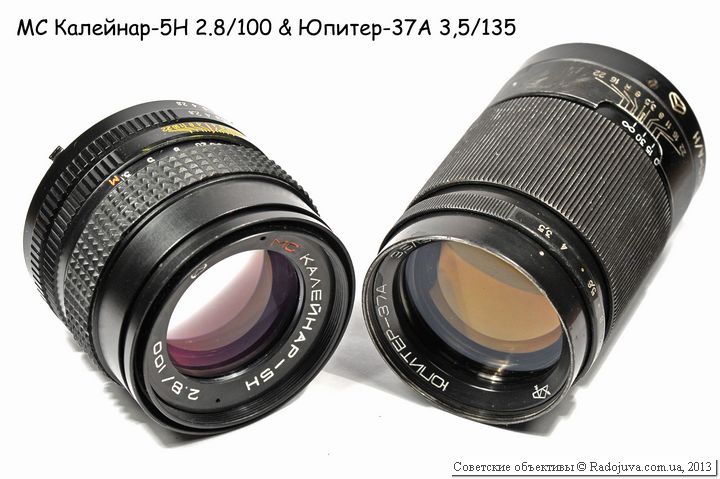
Two great portrait lenses
Why is all this necessary?
And due to the fact that now Soviet and other old optics can be bought, roughly speaking, for a penny and playing, you can get better masterpieces than on the Nikkor 135mm F2.0 DC. And manual optics gives more understanding about the shooting methods, develops a different approach to the whole process of photographing, makes you take pictures more deeply and more thoughtfully.
As they say, love is not just for you, you have to deal with it, the same applies to Soviet and other old lenses.
What manual lens to choose for a start?
I am often asked what manual lens to buy. There can be no single answer, since each lens is designed for different purposes. But still, if you need my advice, then I recommend lenses for use on modern Nikon cameras that do not need adapters, which have an excellent price / quality ratio, that are easy to find and use.
From Soviet lenses:
- Helios-81N 50mm F2.0 MC - very sharp, fast, suitable for portraits on DX cameras, gives an interesting picture with twisted bokeh. I recommend it as the first Soviet lens. No adapter required.
- Helios-123Н 50mm F1.4 МС - Super fast, good for DX portraits, good bokeh, great for creative shots. No adapter required.
- Granite-11N 80-200mm F4.5 MC - an inexpensive Soviet zoom lens, easy to use and commercially available. No adapter required.
- Jupiter-37AM 135mm F3.5 MS и Jupiter-37A 135mm F3.5 with a KP-A / N shank (both versions of MS and not MS are good) - a good portrait lens, gives a very high-quality picture. Requires KP-A \ N shank.
- Jupiter-21A 200mm F4.0 with KP-A / N shank - tele lens, will help to reach distant objects. The image quality is very high.
- Tele-H 200mm F3.5 - good fix telephoto. No adapter required.
- Jupiter-11A 135mm F4.0 - a good portrait lens, an alternative to Jupiter-37A
- Tair-11A 135mm F2.8 - an excellent portraitist. Requires KP-A \ N shank.
- Mir-73N 20mm F2.8 MS - a wide-angle high-aperture lens for those who need a wide viewing angle. No adapter required.
- Zenithar 16mm F2.8 MC Fisheye - ultra-wide-angle fast lens with a unique distortion of the perspective of the "Fisheye" class. No adapter required.
- MS Bearing 3,5 / 8A - a unique circular fisheye lens for full-motion cameras.
- Kaleinar-5N 100mm F2.8 MS - super sharp short high-aperture telephoto. One of the best. Dear. Very high image quality. No adapter required.
- Mir-24N 35mm F2.0 MC - good standard high-aperture fix. No adapter required.
- MS Vega-28 120 / 2,8 - Medium format lens, on full frame and crop cameras can serve as an excellent portrait lens. Installed using a special adapter with the ability to focus to infinity.
- For Nikon 1 system cameras, they are perfect and cheap rangefinder lenses like Jupiter-8 2/50
I advise you to look at the page with voting for the best portrait soviet lens, and the best Soviet fifty dollars.
From Nikon lenses (Nikkor, Nippon) for creativity:
- Nikon 50mm f / 1.4 Nikkor-S Auto NON-AI - a good old fifty dollars. There are many modifications, almost all of them are very good.
- Nikon 100mm f / 2.8 Series E - good and not very expensive portrait lens
- Nikon 105mm f / 2.5 Nikkor AI - great portrait lens, price bites a little, but worth it.
- Nikon 135mm f / 2.8 Nikkor-Q Auto Non-Ai or any Nikon 135 / 2.8 is a good portrait lens.
- Nikon 180mm f / 2.8 ED Nikkor AI-S - a dream lens, a good prime telephoto lens, a super-portrait lens. Relatively expensive.
- Nikon 200mm f / 4 NIKKOR-Q - an inexpensive, pleasant long-focus fix.
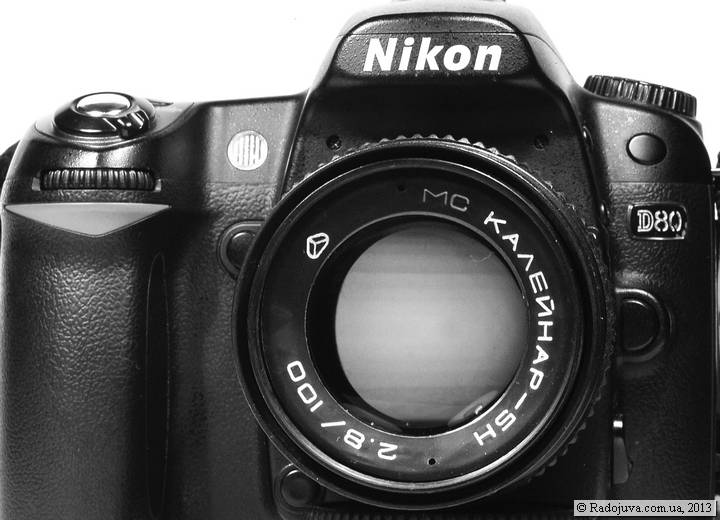
MS lens Kaleinar-5n on the Nikon D80 camera
For publicity:
The largest catalog of lenses and photographic equipment on the site G. Abramova, “Stages of development of domestic camera manufacturing".
Also, a large selection of Soviet lenses on the site http://www.fotorox.ru/.
Personal experience:
I wrote a lot of text with a lot of obscure terms and all sorts of subtleties and nuances for beginners. Do not think that everything is so complicated. Everything is very simple, it is enough to use a manual lens for 1-2 days. If you do not know whether you can work with such a lens, you can perform the following test. The essence of the test: turn off the auto focus on your camera or lens, switch to M mode, turn off the auto ISO, set the flash to manual. Thus, you get an analogue of a manual lens. Try shooting with manual settings excerpts and aperture and manual focus. If you do it, then it will work with old lenses. Good luck
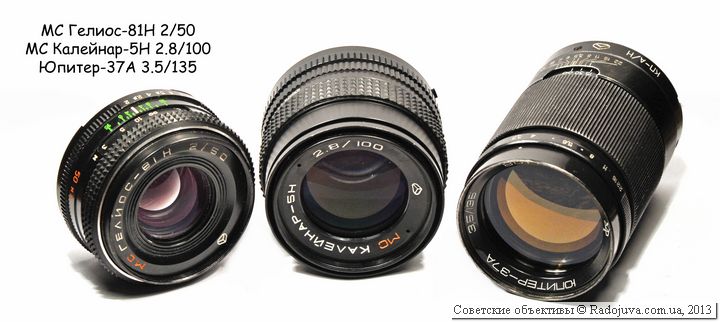
Popular Soviet lenses
Conclusion:
Old lenses found their rebirth on modern digital SLR cameras. Many old manual lenses can be used on Nikon cameras without adapters while maintaining functionality. The quality of the created image at a low cost makes the old manual optics very, very attractive for amateurs and professionals.
Another article of mine on Soviet optics is here.
Comments on this post do not require registration. Anyone can leave a comment. Many different photographic equipment can be found on AliExpress.
Material prepared Arkady Shapoval. Training/Consultations | Youtube | Facebook | Instagram | Twitter | Telegram



For you personally (I see you like this turn of speech): if a person writes 'change', then please write an exact model of the toro that you are changing.
And it looks the same: I change two Nikon cameras (with an 'N' mount) for a Canon camera. And do not care that those and those two dozen models.
In the end, you finally understand that I need any (!) Light and sharp autofocus (!) Lens for Nikon. Preferably 85, better than 105. For macro - garden birds, flowers, insects ... And this is by no means accidental - there is a good reason, because I would never part with those lenses that I mentioned above. In addition to various age-related ailments, I have diabetes, plus cataracts are progressing, and this will completely and irrevocably prevent focusing through the eyepiece. It is clear that everyone will rush to change the modern Nikon 105 for my excellent ones, but ... manuals are not necessary, but ... But ... what if !? After all, last year I bought a brand new (!) Nikonovsky 70-300 mm (which for many years costs under $ 600) for 105 dollars. Not bought from hands! In the intermage. I don't know why, but ... at a price affordable even for a pensioner. I do not find obvious “marriages”. I still can't see a better one. By the way, about the case. And today I myself took out three picture tube (Phillips) TVs to the trash, they are five years old, they all work, but we need digital tuners. We, with the help of children, bought flat TVs - they require less space. That week, hired workers took out an oak Czech wall to the trash bin, handed over 2500 books, filing of Soviet magazines, a nice bag of large and small photo junk (enlargers, a flashlight, a timer, ten canisters, trays, chemicals, tweezers, cassettes, etc.) etc.), two bags of locksmith's junk - a screwdriver without batteries, a wall-cutter-grinder, etc. electro-mechanical, locksmith, carpentry and shoe tools (the reason for the "generosity" of these said above). Sell? No, I don’t want to do it ... Calls, bargaining ... Everyone wants to buy for a penny, also with delivery (loading). It's easier for me to take everything out to the trash, and they'll quickly pick it up ...
...
..
By the way, a list of optics with a N mount was already published previously. When installing such lenses on Nikon there will be no problems, but to install on Canon, you will need an adapter.
Do we have a troll raid?
Hello, how to connect the lens of world 3 with a Samsung nx 1000 camera, is there a special adapter or do I need to saw it? I didn’t find anything on the Internet or was not looking there. Is there an adapter 42 to samsung nx, what else is needed?
It is very accessible and almost all questions are described, for which thank you very much for such a description. Only with your permission, there is an underwater reef in using old Soviet lenses (say, the Arsenal factory) on Nikon digital SLRs. Be sure to check the jumping aperture. You can twist the lens with a faulty diaphragm and it will be impossible to shoot yourself.
I had such a thing.
From the above described, Nikon adherents who take landscapes with adapters are better off not connecting. An adapter without a lens for infinity will not give a result, but with a slins the quality will be worse. The conclusion is to save denyushku say for Nikon 28 1.8G on FF. With portrait painters, things are different, you can shoot without a lens * on some manual lenses. But it seems to me that the best option is the use of medium-format optics where even the full matrix will be taken everything from the middle of the lens. If it covers 6x6, then the quality at 24x36 will certainly + infinity also benefit. The only question is whether there will be confirmation of sharpness say Wave 3 and Nikon D 700? What do you think?
medium format optics may not pull high resolution.
What Soviet optics work well on the Nikon D3300? and what kind of adapters are gentle if they are needed?
READ THE ARTICLE, THE LOADER!
Yes you go!
Helios-81N 50mm and Mir 20N 20mm is what will probably be good ... fits as it is ... to Nikon (manuals)
I read to the d3300 I need good optics!
Everybody needs good optics ... and for any camera ... a question of money. Those who have money do not ask these questions ... they take long-proven optics with a gold ring.
My d3300 has excellent sharpness and gives a picture with standard lenses. If you buy something better, then only the pros with a gold ring. And so for the soul you need to have Helios-81N, he gives a macro and a portrait with a very unique beck. Mir-20N is something that can be taken from inexpensive shirikov and not regret it.
I had a lot of Helios-81H. There are two versions with 50mm and 53mm focus ... So they work about the same, but personally it seemed to me that 53mm gives a more artistic picture, I left myself the rest ...
Thank you!
I completely forgot about the “Jupiter-37 MS”, the same goes for Nikon without alterations, only the transition must be bought from the thread to the mount for a good lens. And here is a photo of Mir-20
I see you understand my promise to you.
You don't have to answer people like that ... better keep silent and if you write, then write on the case ...
D90 camera + Helios 44m lens + adapter with a Pixco M42-Nik lens = soap image at any distance, there’s also a slight backlash .. I don’t understand what’s the matter: either the adapter is of poor quality, or am I doing something wrong ?? I would be grateful for the answer!
And how to answer those who are looking for a tulku or glass with “masterpiece” buttons, but do not want to read?
Thank you, very informative!
Actually, it wasn’t for you, but it turned out
An interesting addition: I wound up Helios 44-2 - it gives sharpness beyond 3 meters only with a completely closed aperture.
Sorry for the spam, I found an article about lens adapters! Many thanks to the author for a detailed analysis and in general for this site!
Svetlana, do not take the transition with the lens ... passed and hopeless stage ... the lens spoils all the raspberries. Option or Canon carcass or adjusting to the lens specialists.
From experience, Helios can only be used as a portrait or macro, you will not get decent general shots on it, it does not allow it into the distance. I advise you to sell it and buy a 35 / 1,8 or 50 / 1,8 with auto focus and rejoice ... if you want to play, then everything is in your hands ...
Friends! Please tell me, what are some Chinese analogs of the adapter ring for the B-mount. on the Nikon d3200? What are they called and where to buy?
Soviet ring kp-88 / n. Unfortunately, it is rare, but I was presented with Jupiter 36v I would like to try it in practice! I would be very grateful for the constructive advice!
Thanks for the info helpful!
and which lens for Nikon s 1 mirrorless lens is suitable Soviet lens? or only for SLRs? I did not quite understand: (for Nikon adapters are very expensive are there Soviet adapters?
Almost any lens can be attached there, the question is why :)
The focal length of the Nikon 1 mount is only 17 mm, so there are adapters for any SLR and rangefinder systems; for example, with M42 (Soviet mirror): http://goo.gl/vvnhc2, with M39 (rangefinder): http://goo.gl/AJlOSl
http://ali.pub/2i8cik
it just seems to me that the photo will be better, but how do you think it is?
It depends entirely on the hands of the photographer, personal preferences and ideas about “quality”.
Old manual optics has its advantages, it:
1) as a rule, more aperture than the "whale";
2) a more "interesting" pattern due to the imperfection of the optical circuit and characteristic distortions;
3) inexpensive.
No masterpieces will happen by itself, no matter what lens you attach; it is up to you.
If you like to experiment - go ahead. In any case, this is a rewarding experience.
A much larger number of old Soviet lenses are suitable for a mirrorless - due to the short focal length of the lenses. For example, lenses from FED, Smena, etc. DSLRs never dreamed of this (except for macro photography). And also - for a mirrorless, you can easily make a TILT-SHIFT lens.
If you replace the focusing screen, will the highlighting of the focus points and marking lines remain or not on the nikon D600?
will stay
Arkady, thanks for the next great article.
Simon, thanks for the beautiful photos. No matter what they say, the Soviet optics have their own special handwriting, and in the skillful hands of the photographer you can get wonderful pictures with it.
good evening
can anyone give advice
nikon d 80 + helios 81n the green focus point is constantly blinking. does not light up. there is no problem with the nikon d5000 with this lens
other manual lenses on d80 are also tested. the result is the same
Screw another lens to the D80, you can even whale.
Turn off autofocus, try focusing on it with your hands.
If the circle also blinks on it, then the problem is in the carcass.
Thank you
I know that the problem is in the carcass, I hope to hear a hint
The master had the carcass, for diagnostics all parts were replaced, boards (except the power board) sensors, shmensors, in general, everything
Everything is working and does not require replacement, but the problem remains - the bulb constantly blinks on the manual and does not confirm the focus, but on Nikorov’s it turns it there — trying to focus back and makes a shot with a miss
is everything normal with the lever that controls the lens aperture? Look at the open aperture of the lens when it is attached to the camera, or closed. The camera behaves this way, if the diaphragm is closed - it cannot focus, this is clearly visible on non-native lenses - if you put, say, a U-37A on the camera and close the aperture more than 5,6 - 8 (depending on the carcass), then the point on the camera stops working. On Nikon lenses, the diaphragm should always be open when the lens is mounted on the carcass. The problem may be that the lever in the carcass does not work and the aperture of the native lens is always covered, or the problem is in the autofocus module itself or in the second mirror of the camera.
Excluded1. Aperture constantly open At any value, triggers during shutter release
2. auto focus module working-changed for diagnostics
3. mirrors in the field and with them everything is in order
Can you not flood here? WRITE TO WHOM THREAD IN THE FACE ...
Then why didn’t you write to me in PM, but flood HERE?
This comment is about compatibility of SOVIET OPTICS (the topic is by the way about ETH) with nikon and was created so that it could be seen by the maximum number of people and, if possible, prompted
And through a personal whom do you suggest I communicate with? Do you know a person who can help me?
Go to the forums and chat about your broken machine ...
Yeah!
You chat! And not justified!
If I violated at least one of these points described on the site, I will be happy to end this conversation and leave
AF module after removal and installation must be adjusted
Entot your master doesn’t work in Nikans!
Look for a friend of the master, shtoba he vama smacked the system of phasing!
and Tagda wakes you all to work!
Good day! Searching for comments did not find such questions, so I decided to ask. I am looking for a lens for subject shooting. Subjects of medium size. First of all, I need a large depth of field, minimal distortion, excellent sharpness. At the moment I use Helios 81H 2/50 on the Nikon 5100. I want a significant upgrade of the lens (from Soviet or old Nikon).
Dear Volodya ... you looked badly ... go to YouTube so everything you need and not only tell you, but also show you. https://www.youtube.com/results?search_query=%D0%BF%D1%80%D0%B5%D0%B4%D0%BC%D0%B5%D1%82%D0%BD%D0%B0%D1%8F+%D1%81%D1%8A%D0%B5%D0%BC%D0%BA%D0%B0
And here is a simple language https://www.youtube.com/watch?v=qKu3nPHd2XY
For anyone who is interested in how to use Soviet manual lenses with preservation of infinity, here is the link: http://dphotoworld.net/publ/ehto_interesno/bitva_za_beskonechnost_ili_stavim_gelios_44m_7_na_nikon/5-1-0-227
We'll have to work, of course, but it's worth it. I have already altered 2 lenses: "Helios" and "Zenitar".
Thank you for the article. A lot of useful information. Saved to favorites, from time to time I look here when I need to clarify something on the lenses. Once again, thanks to the author for his work !!
how to use a lens from Krasnogorsk-3 with respect Sergey
Nothing sensible happens. Do not bother.
with torment and dancing with a tambourine.
"Lenses from 'U' enlargers
In those distant times, when film rules, there were photo enhancers to work with negatives and positives ”
Correct the last word))
I also join in the thanks for the article. I want to ask a question: will all lenses with M42 lose infinity when using a lensless adapter, or does this only apply to Soviet lenses? Maybe the imported ones had different working lengths? For example, will the AUTO-BEROFLEX MC 5200mm / 135: 1 lens become normal on the Nikon d2,8? Thank you in advance for your reply.
https://radojuva.com/2013/10/auto-beroflex-3-5-135mm/
All M42 lenses will lose infinity on Nikon, because it’s not just a thread, but a standard with a working length of 45.45 mm
Hello. I have Nikon D3200. and eats two old lenses Jupiter-37a 3.5 / 135 and Industar-23 4,5 / 110. Can I connect them? What adapter do I need. Thank you
https://radojuva.com/2011/02/obzor-jupiter-37a-otzuvu-yupiter/
https://radojuva.com/2013/01/obzor-industar-23-u-4-5-110mm/
Here is a ring to put Jupiter
https://lexfoto.com.ua/m42-nikon-f-lens-pixco.html
and this is also industrial
https://lexfoto.com.ua/m39-m42.html
but on the second there will be no infinity